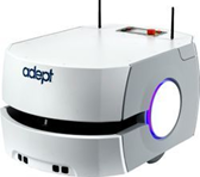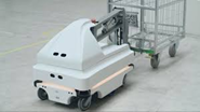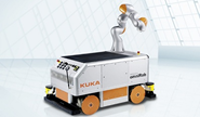Become a member
Take advantage of exclusive member benefits, world class events, networking and specialist support








 Become a member
Become a member 


 Autonomous mobile robots & Guides vehicles’
Advanced robotics
Autonomous mobile robots & Guides vehicles’
Advanced robotics
AGVs (Automated Guided Vehicles) have been available as an alternative to forklift trucks for some time. The development of technologies for sensing, mapping and navigation has also allowed for the introduction of Autonomous Mobile Robots (or Industrial Mobile Robots) over the last decade. Given that the two terms are used interchangeably it’s worth considering the differences and suitability for different applications.
Note that we only refer to ground-based vehicles in this article, with no distinction being made between wheels and tracks. It’s also assumed that the robots are working in an indoor environment.
The key characteristic of an AGV is that it’s a guided vehicle, with information being transferred via marked floor lines/wires, radio beacons, camera systems or lasers. These ensure that the vehicle stays on a set path. Initially used in warehousing and logistics, such vehicles have also come to replace forklift trucks in factory settings. They are often kept separate from humans for reasons of safety.
Autonomous Mobile Robots (also known as Industrial Mobile Robots) differ in their free navigation of workspaces. This means that AMRs autonomously map and plan their own routes for maximum safety. While AMRs have the benefit of being able to re-plan routes if there are obstructions, AGVs can’t do this without human intervention.
AGVs are generally considered to be more predictable than AMRs, with known arrival times and routes. While AMRs offer a high level of flexibility, there’s the potential for workflows to be delayed where obstacles have to be navigated.
Original AGV and AMR designs were based on adapted forklift truck platforms, with many of the traditional characteristics being retained to this day.
As interest in the AGV/AMR market has grown these three types have become common:
The flat top ARM design has become most common over the last decade. This is because they have typically been built from the ‘ground up’, allowing for the integration of navigation technologies and different payloads (such as conveyors or industrial robot arms).
While most AMRs are produced by new market entrants, established tow and fork truck manufacturers offer ‘autonomy-ready’ vehicles. The autonomous navigation technologies can be fitted either during or after production.
An American National Standard describing Industrial Mobile Robots (ANSI/RIA 15.08 Part 1) was published in December 2020. The standard focuses on the AMR robot variety. Although yet to be harmonised internationally, it provides useful definitions for the types of AMRs in use:
| Type A | Autonomous Mobile Robot (platform only) |  |
| Type B | Type A plus a passive or active attachment that is not a manipulator. |  |
| Type C | A mobile manipulator, where the manipulator is what would be considered an industrial robot, mounted to a mobile platform that could be either an IMR Type A or an AGV |  |
AVG navigation technologies may feature an electro-magnetic tape, wire (embedded in the facilities floor), or beacon system (utilising radio, vision or lasers). It’s common for a map to be integrated within the AGV control system, with pre-planned and plotted routes. In these systems navigation is provided by beacons or scannable images (e.g., 3D barcodes) along the vehicles route.
In the case of AMRs, the navigational choice depends mainly on the operational environment. Static-based mapping systems use laser guidance, with the assumption that the environment rarely changes. For more dynamic environments, SLAM (Simultaneous Localisation and Mapping) allows the robot to scan its surroundings and update its map as it changes. Static and dynamic mapping may be combined for best results.
Traditional AGVs tend to rely on magnetic or laser sensors for guidance. However, bar code scanners (laser or vision based) are often used for workspace positioning. There is also the option of using radio beacons and triangulation. However, this method is known to be unreliable in facilities with a large amount of metal racking, such as warehouses.
Focusing on dynamic mapping and guidance (SLAM based), we see the use of laser senses for the 3D mapping of environments, including obstacles. Known as LIDAR, this technology is similar to that found in autonomous road vehicles. It can be supported with machine vision for the creation of a visual map. In this instance, the robot can use the LIDAR for long-range sensing/planning and visual representation.
Computer vision software developments have allowed for the integration of Visual SLAM, with cameras being used for dynamic mapping. This means that the use of expensive and fragile LIDAR systems can be avoided.
Sensor choice is particularly dependent on the operating environment, with most AGVs and AMRs using systems for work in controlled indoor environments. There is a convergence on the technology used for autonomous vehicles specific to applications outside the factory.
As is commonly the case, safety standards lag behind the pace of technological development. For many years there was no relevant standard for AGVs or AMRs.
However, ISO3691-4:2020 was published in February 2020, covering the safety requirements of driverless trucks and their systems. Having not been published in the European Commission’s official journal, this standard is not harmonised Type-C under the Machinery Directive or the UK’s Supply of Machinery (Safety) Regulations.
Still, ISO3692-4 includes helpful information and guidance for safe AGV/AMR design. A useful standard for the growing robotics market, it is expected to be harmonised in the future. Until then its use will be restricted to the proof of conformity. It should be used in conjunction with other standards and thorough risk assessments.
It’s also worth noting that a mobile robot carrying an industrial robot should be referred to as a hybrid robot. ISO10218 should be one of the standards considered in such instances.
AGVs have primarily been used for the automation of item transportation in warehouse settings, with factory use limited mainly to the automotive industry. Regardless of industry, the products being carried have been typically of a pallet size and over 250kg. Some organisations have used AGV tow trucks to transport smaller kits of parts to line-side operations for the support of lean just in time manufacturing.
The development of the AMR market has led to lower-payload vehicles coming to the fore, with an emphasis on moving smaller items. A common use has been in the movement of goods to man picking (typically for e-commerce). However, additional uses are being found, with robots proving particularly useful in the transfer of smaller items from workstation to workstation or from storage to point of use.
AMRs complete with robot arms are being used across both the warehousing and manufacturing spaces. In warehouses there is growing but nascent market for AMRs that not only transport goods but also pick them from shelves. Such AMRs are also being used in manufacturing, where a fixed robot installation wouldn’t be cost effective or flexible.
AGVs and AMRs offer a number of benefits in the contexts of warehousing and manufacturing. The removal of the human driver has resulted in the decreased risk of collisions between vehicles and equipment, thereby increasing peoples’ safety. Overall efficiency can also be improved as AGVs and AMRs are also less prone to mistakes.
Investment cost is often cited as a drawback of both AGVs and AMRs. However, falling year-on-year costs mean that the adoption of a long-term approach is likely to compare favourably against manual methods in terms of ROI.
The inherent lack of AGV flexibility can be viewed either as a drawback or a benefit, given that they ensure a predictable workflow. However, there will be the risk of delays and bottlenecks where an AGVs route is blocked. Such issues can be avoided through the use of dynamic AMRs, which are able to re-plan their routes for optimum flexibility. The potential for unpredictable workflow schedules should be borne in mind here.
Andersson, Thomas. AGV & AMR Robotics 2020. London : STIQ Limited, 2020.
Kidman, Dr Martin. ISO 3691-4:2020 – A new standard for industrial driverless trucks. LinkedIn. [Online] July 10, 2020. [Cited: April 20, 2021.] https://www.linkedin.com/pulse/iso-3691-42020-new-standard-industrial-driverless-kidman-phd/
Association for Advancing Automation. Association for Advancing Automation. [Online] 12 25, 2020. [Cited: 04 20, 2021.] https://www.automate.org/store/products/new-ansi-ria-r15-08-1-2020-american-national-standard-for-industrial-mobile-robots-safety-requirements-part-1-requirements-for-the-industrial-mobile-robot-pdf. RIA15.08 Part 1.
Gerstenberger, Michael. Preview of R15.08 Industrial Mobile Robot Safety. Ann Arbour : Association for Advancing Automation, 2019.
ONIT. What is Visual SLAM. Dragonfly CV. [Online] [Cited: 04 20, 2021.] https://dragonflycv.com/.